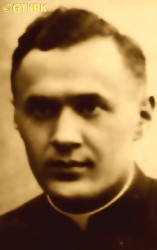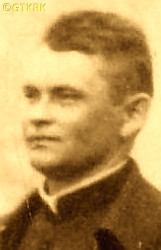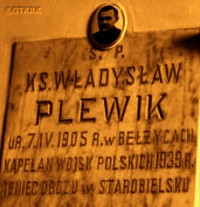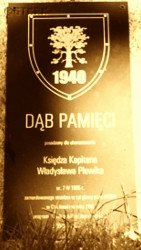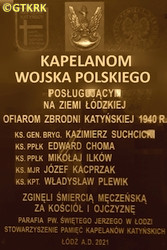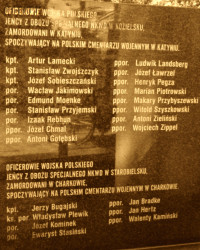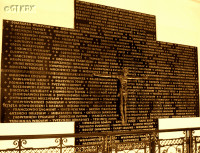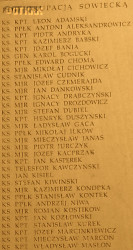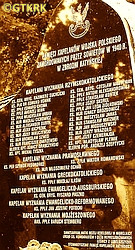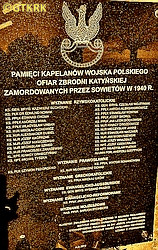Roman Catholic
St Sigismund parish
05-507 Słomczyn
85 Wiślana Str.
Konstancin deanery
Warsaw archdiocese, Poland
full list:
displayClick to display full list

searchClick to search full list by categories
wyświetlKliknij by wyświetlić pełną listę po polsku

szukajKliknij by przeszukać listę wg kategorii po polsku

Martyrology of the clergy — Poland
XX century (1914 – 1989)
personal data
surname
PLEWIK
forename(s)
Vladislav (pl. Władysław)
function
diocesan priest
creed
Latin (Roman Catholic) Church RCmore on
en.wikipedia.org
[access: 2014.09.21]
diocese / province
Łódź diocesemore on
en.wikipedia.org
[access: 2013.05.19]
RC Military Ordinariate of Polandmore on
en.wikipedia.org
[access: 2014.12.20]
honorary titles
War Order of Virtuti Militari — Silver (5th Class)more on
War Order of Virtuti Militari – Silver (5th Class)
(11.11.1976, Londontoday: London Cou., England, United Kingdom
more on
en.wikipedia.org
[access: 2024.03.19], decree of Stanislav Ostrowski, President of the Republic of Poland in exile)
September Campaign Crossmore on
September Campaign Cross
(01.01.1986, Londontoday: London Cou., England, United Kingdom
more on
en.wikipedia.org
[access: 2024.03.19], decision of George Premyslav Morawicz, Minister of Military Affairs of the Polish Government in exile)
date and place
of death
04.1940

NKVD KharkivHQ at 5 Sovnarkomskaya Str.
today: 5 Mirronosits Str., Kharkiv urban hrom., Kharkiv rai., Kharkiv obl., Ukraine
more on
en.wikipedia.org
[access: 2022.08.05]
alt. dates and places
of death
05.1940
details of death
On 28.04.1939 appointed chaplain of the Polish Army reserve, with seniority from 01.01.1939.
In 08.1939, mobilized, in the rank of captain, according to some sources, to the Marcin Kątski's Volyn Artillery Reserve Cadet School in Volodymyr–Volynskyi, territorially belonging to the Command of the Corps District DOK No. II Lublin.
After the German and Russian invasion of the Republic of Poland in 09.1939 and the start of World War II, took part in the September Campaign in 1939.
Taken prisoner by the Russians after 17.09.1939 in unknown circumstances.
Held in the NKVD filtration camp PFL Shepetivka.
From there, in 10‐11.1939, transported to the KLW Starobilsk concentration camp in Starobilsk.
Prob. not recognized by the Russians as a military chaplain and therefore not transported, together with most of the chaplains from KLW Starobilsk, to the KLW Ostashkov concentration camp in Ostashkov on 23.12.1939.
Finally, placed at the disposal of the head of the NKVD Directorate of the Kharkiv Oblast and taken from KLW Starobilsk — in a transport organized by the Moscow NKVD headquarters — to the place of execution in Kharkov: his name is included in the list of records of prisoners of war who left the camp in Starobilsk, entry number 2578.
There, in the headquarters of the genocidal Russian organization NKVD, was murdered.
His body was thrown into a mass death pit in Lyesopark, the NKVD summer resort.
By Polish Minister of Defence’s decision No. 439/MON of 05.10.2007 posthumously promoted to the rank of lieutenant captain (by mistake — should have been promoted to the rank of major).
prisoner camp's numbers
2578 (KLW StarobilskClick to display the description)
cause of death
mass murder
perpetrators
Russians
sites and events
NKVD KharkivClick to display the description, «Katyn genocide 1940»Click to display the description, KLW StarobilskClick to display the description, Moscow (Butyrki)Click to display the description, PFL ShepetivkaClick to display the description, Ribbentrop‐MolotovClick to display the description, Pius XI's encyclicalsClick to display the description
date and place
of birth
07.04.1905Birth certification on:
www.familysearch.org
[access: 2025.08.19]

Bełżycetoday: Bełżyce gm., Lublin pov., Lublin voiv., Poland
parents
PLEWIK Paul
🞲 ?, ? — 🕆 ?, ?

WOJTOWICZ Francesca
🞲 ?, ? — 🕆 ?, ?
baptism
08.04.1905Birth certification on:
www.familysearch.org
[access: 2025.08.19]

Bełżycetoday: Bełżyce gm., Lublin pov., Lublin voiv., Poland
St Paul the Apostle RC church
presbyter (holy orders)
ordination
02.09.1934

Łódźtoday: Łódź city pov., Łódź voiv., Poland
more on
en.wikipedia.org
[access: 2021.07.18]
positions held
1936 – 1939
vicar — Tomaszów Mazowieckitoday: Tomaszów Mazowiecki urban gm., Tomaszów Mazowiecki pov., Łódź voiv., Poland
more on
en.wikipedia.org
[access: 2021.09.29] ⋄ St Anthony of Padua RC parish ⋄ Tomaszów Mazowieckitoday: Tomaszów Mazowiecki urban gm., Tomaszów Mazowiecki pov., Łódź voiv., Poland
more on
en.wikipedia.org
[access: 2021.09.29] RC deanery — also: prefect of elementary schools in nearby villages and supervisor of the local Polish Scouting and Guiding Association ZHP unit
1934 – 1936
vicar — Krzepczówtoday: Grabica gm., Piotrków Trybunalski pov., Łódź voiv., Poland
more on
en.wikipedia.org
[access: 2022.01.28] ⋄ St Adalbert the Bishop and Martyr and Nativity of the Blessed Virgin Mary RC parish ⋄ Piotrków Trybunalskitoday: Piotrków Trybunalski city pov., Łódź voiv., Poland
more on
en.wikipedia.org
[access: 2021.07.29] RC deanery — also: prefect of elementary schools in nearby villages
1929 – 1934
student — Łódźtoday: Łódź city pov., Łódź voiv., Poland
more on
en.wikipedia.org
[access: 2021.07.18] ⋄ philosophy and theology, Theological Seminary
others related
in death
CZEMERAJDAClick to display biography Joseph, DROZDOWICZClick to display biography Ignatius, NIWAClick to display biography Andrew, SWIRTUNClick to display biography Alfred, TCHÓRZEWSKIClick to display biography Vladislav, TYBOROWSKIClick to display biography Stanislav, WRAZIDŁOClick to display biography George Adam
sites and events
descriptions
NKVD Kharkiv: On 05.04‐12.05.1940 Russians executed in NKVD headquarters at 5 Sovnarkomskaya Str. (today 5 Mirronosits Str.) in Kharkiv c. 3,739 Polish prisoners of war (POW) kept in KLW Starobilsk concentration camp in Starobilsk. This genocide was the implementation of the decision of the Russian Commie‐Nazi authorities — the Politburo of the Russian Commie‐Nazi party — of 05.03.1940 to exterminate tens of thousands of Polish intelligentsia and servicemen, held in Russian camps established after the German‐Russian Ribbentrop‐Molotov Agreement and the annexation of half of Poland by the Russians in 1939, known as «Katyn genocide». After the formal „verdict”, the NKVD Special Council Moscow, i.e. the genocidal Russian kangaroo court known as the «NKVD Troika», sent successive disposition letters to the NKVD in Kharkiv — there were c. 36 of them — containing the names of the persons to be murdered. The murders were committed in the NKVD District Directorate HQ, at 3 Dzerzhinsky Sq. Convoys of prisoners were transported by rail to the Kharkov railway station, and from there by car to the NKVD headquarters. The victims' hands were tied behind their backs with a rope and at night they were taken to a windowless room in the basement. There, they were murdered with a shot in the neck from a 7.62 mm Nagant revolver. Immediately afterwards, the bodies were taken away in trucks and buried in mass graves near Kharkov, 1.5 km from the village of Piatykhatky. Prob. also later, till 06.1940, an unknown number of Poles from the so–called «Ukrainian Katyn List» or «Tsvetukhin's list» were murdered there in the same way. (more on: en.wikipedia.orgClick to attempt to display webpage
[access: 2014.09.21])
«Katyn genocide 1940»: 05.03.1940, the Russian Commie‐Nazi authorities — the Politburo of the Russian Commie‐Nazi party headed by Joseph Stalin — made a formal, secret decision No. P13/144 to exterminate tens of thousands of Polish intelligentsia and military personnel, „declared and hopeless enemies of the Russian government”, held in Russian camps, as a consequence of the German‐Russian Ribbentrop‐Molotov Agreement, the invasion of Poland and annexation of half of Poland in 09.1939, and the beginning of World War II. The decision was, as it were, „sanctioned” by the verdicts of the NKVD Special Council, i.e. the genocidal Russian kangaroo court known as «NKVD Troika» in Moscow. The implementation in Ukraine and Belarus was made possible by order No. 00350 of 22.03.1940 of the head of the NKVD, Lavrentiy Beria, on the „unloading of NKVD prisons”, i.e. transfer of prisoners from several prisons in Ukraine and Belarus to central prisons, e.g. in Kiev or Minsk. The genocidal «NKVD Troika», after issuing sentences, also sent to local NKVD units, NKVD disposition lists — i.e. lists of convicts — each containing on average c. 100 names. Named lists are known — may be reconstructed — for people held in the KLW Kozelsk and KLW Ostashkov camps, but not for KLW Starobilsk, known for victims from Ukrainian prisons, but not Belarusian ones. It is not even known exactly how many lists there were, mainly because the number of them sent to the NKVD in Belarus is unknown. On 03.03.1959 Alexander Shelepin, then head of the Russian KGB, in a handwritten note stated: „ Since 1940, the Committee for State Security under the Council of Ministers of Russia, has been keeping records and other materials relating to the prisoners of war and interned officers, gendarmes, policemen, etc., people from former bourgeois Poland shot that year. In total, based on the decision of the special troika of the NKVD of the USSR, 21,857 people were shot, of whom: 4,421 people in the Katyn Forest (Smolensk Oblast), 3,820 people from the Starobilsk camp near Kharkov, 6,311 people from the Ostashkov camp (Kalinin Oblast), and 7,305 people in other camps and prisons in Western Ukraine and Western Belarus. The entire operation of liquidation of the above–mentioned was carried out on the basis of the Resolution of the Central Committee of the CPSU of 05.03.1940”. The head of the NKVD recommended to the Russian leader, Nikita Khrushchev, to destroy all personal files of those shot in 1940, but to keep the minutes of the meetings of the «NKVD Troika» and confirmations of the implementation of the decisions of the «NKVD Troika». A one–sentence draft resolution was attached to the note. It is not known whether the resolution was accepted and whether the files were destroyed. The aforementioned protocols and confirmations of the «NKVD Troika» are also not known. There are indications — i.e. four so‐called „NKVD‐Gestapo Methodical Conferences” of 1939‐1940: in Brest on Bug, Przemyśl, Zakopane and Cracow — of close collaboration between Germans and Russians in realization of plans of total extermination of Polish nation, its elites in particular — decision that prob. was confirmed during meeting of socialist leaders of Germany: Mr Heinrich Himmler, and Russia: Mr Lavrentyi Beria, in another German leader, Mr Hermann Göring, hunting lodge in Rominty in Romincka Forest in East Prussia. (more on: en.wikipedia.orgClick to attempt to display webpage
[access: 2023.12.15])
KLW Starobilsk: Russian Rus. Концентрационный Лагерь для Военнопленных (Eng. POW Concentration Camp) KLW, run by genocidal Russian NKVD organization, for Poles arrested after the invasion in 1939, operating in 1939‐1940 in Starobilsk — on the premises of the „All Afflicted Joy” Icon of Our Lady Orthodox monastery, looted and closed by Russian Bolsheviks in 1923. In 04.1940 c. 3,800 were kept there (in 11.1939 — 11,262) — per captive there was c. 1.25 m2 of bunk space on which they had to sleep, eat and keep their belongings, initially the receiving only one meal a day. Subsequently— as the fulfillment of Russian government decision to exterminate Polish intelligentsia and prisoners of war camps (Polish holocaust) — were executed in Kharkiv. Among the victims were 8 generals, 55 colonels, 127 lieutenant colonels, 230 majors, c. 1,000 captains, and c. 2,450 lieutenants and second lieutenants of the Polish Army. Almost half were reserve officers: over 20 professors of universities, all without exception scientific staff of the Anti‐Gas Institute of the Polish Army and almost the entire staff of the Institute of Armament of the Polish Army, c. 400 doctors, several hundred lawyers, several hundred engineers, c. 100 teachers, c. 600 pilots , many social activists, several dozen writers and journalists. Used as a concentration camp for Poles later as well. (more on: pl.wikipedia.orgClick to attempt to display webpage
[access: 2012.11.23])
Moscow (Butyrki): Harsh transit and interrogation prison in Moscow — for political prisoners — where Russians held and murdered thousands of Poles. Founded prob. in XVII century. In XIX century many Polish insurgents (Polish uprisings of 1831 and 1863) were held there. During Communist regime a place of internment for political prisoners prior to a transfer to Russian slave labour complex Gulag. During the Great Purge c. 20,000 inmates were held there at any time (c. 170 in every cell). Thousands were murdered. (more on: en.wikipedia.orgClick to attempt to display webpage
[access: 2020.05.01])
PFL Shepetivka: Russian Rus. Проверочно‐Фильтрационный Ла́герь (Eng. Testing and Filtration Camp) PFL, where the genocidal Russian NKVD organization carried out selection and isolation of the most „dangerous” or most valuable prisoners — established after the Russian invasion of Poland on 17.09.1939, the establishment of the NKVD Board for Prisoners of War and Internees on 19.09.1939 by the head of the NKVD, Lavrenty Beria, and the order to establish a number of camps for Polish POWs. Operated in 1939‐1940 in Shepetivka, village on the then Polish Ukraine. C. 20,000 prisoners — Polish intelligentsia and soldiers — were held there in extremely harsh conditions: POWs had to sleep on the earth, without food, having to queue few hours for a glass of water. Next POWs were sent to Russian concentration camps and then to mass execution sites. (more on: pl.wikipedia.orgClick to attempt to display webpage
[access: 2013.12.04])
Ribbentrop‐Molotov: Genocidal Russian‐German alliance pact between Russian leader Joseph Stalin and German leader Adolf Hitler signed on 23.08.1939 in Moscow by respective foreign ministers, Mr. Vyacheslav Molotov for Russia and Joachim von Ribbentrop for Germany. The pact sanctioned and was the direct cause of joint Russian and German invasion of Poland and the outbreak of the World War II in 09.1939. In a political sense, the pact was an attempt to restore the status quo ante before 1914, with one exception, namely the „commercial” exchange of the so‐called „Kingdom of Poland”, which in 1914 was part of the Russian Empire, fore Eastern Galicia (today's western Ukraine), in 1914 belonging to the Austro‐Hungarian Empire. Galicia, including Lviv, was to be taken over by the Russians, the „Kingdom of Poland” — under the name of the General Governorate — Germany. The resultant „war was one of the greatest calamities and dramas of humanity in history, for two atheistic and anti‐Christian ideologies — national and international socialism — rejected God and His fifth Decalogue commandment: Thou shall not kill!” (Abp Stanislav Gądecki, 01.09.2019). The decisions taken — backed up by the betrayal of the formal allies of Poland, France and Germany, which on 12.09.1939, at a joint conference in Abbeville, decided not to provide aid to attacked Poland and not to take military action against Germany (a clear breach of treaty obligations with Poland) — were on 28.09.1939 slightly altered and made more precise when a treaty on „German‐Russian boundaries and friendship” was agreed by the same murderous signatories. One of its findings was establishment of spheres of influence in Central and Eastern Europe and in consequence IV partition of Poland. In one of its secret annexes agreed, that: „the Signatories will not tolerate on its respective territories any Polish propaganda that affects the territory of the other Side. On their respective territories they will suppress all such propaganda and inform each other of the measures taken to accomplish it”. The agreements resulted in a series of meeting between two genocidal organization representing both sides — German Gestapo and Russian NKVD when coordination of efforts to exterminate Polish intelligentsia and Polish leading classes (in Germany called «Intelligenzaktion», in Russia took the form of Katyń massacres) where discussed. Resulted in deaths of hundreds of thousands of Polish intelligentsia, including thousands of priests presented here, and tens of millions of ordinary people,. The results of this Russian‐German pact lasted till 1989 and are still in evidence even today. (more on: en.wikipedia.orgClick to attempt to display webpage
[access: 2015.09.30])
Pius XI's encyclicals: Facing the creation of two totalitarian systems in Europe, which seemed to compete with each other, though there were more similarities than contradictions between them, Pope Pius XI issued in 03.1937 (within 5 days) two encyclicals. In the „Mit brennender Sorge” (Eng. „With Burning Concern”) published on 14.03.1938, condemned the national socialism prevailing in Germany. The Pope wrote: „Whoever, following the old Germanic‐pre‐Christian beliefs, puts various impersonal fate in the place of a personal God, denies the wisdom of God and Providence […], whoever exalts earthly values: race or nation, or state, or state system, representatives of state power or other fundamental values of human society, […] and makes them the highest standard of all values, including religious ones, and idolizes them, this one […] is far from true faith in God and from a worldview corresponding to such faith”. On 19.03.1937, published „Divini Redemptoris” (Eng. „Divine Redeemer”), in which criticized Russian communism, dialectical materialism and the class struggle theory. The Pope wrote: „Communism deprives man of freedom, and therefore the spiritual basis of all life norms. It deprives the human person of all his dignity and any moral support with which he could resist the onslaught of blind passions […] This is the new gospel that Bolshevik and godless communism preaches as a message of salvation and redemption of humanity”… Pius XI demanded that the established human law be subjected to the natural law of God , recommended the implementation of the ideal of a Christian state and society, and called on Catholics to resist. Two years later, National Socialist Germany and Communist Russia came together and started World War II. (more on: www.vatican.vaClick to attempt to display webpage
[access: 2023.05.28], www.vatican.vaClick to attempt to display webpage
[access: 2023.05.28])
sources
personal:
www.ordynariat.wp.mil.plClick to attempt to display webpage
[access: 2012.11.23], www.10pul.idl.plClick to attempt to display webpage
[access: 2013.06.23], www.site.belzyce.plClick to attempt to display webpage
[access: 2015.09.30], www.familysearch.orgClick to attempt to display webpage
[access: 2025.08.19], www.muzeumtradycji.plClick to attempt to display webpage
[access: 2017.01.21], www.muzeumtradycji.plClick to attempt to display webpage
[access: 2015.09.30], episkopat.plClick to attempt to display webpage
[access: 2019.10.13]
original images:
www.10pul.idl.plClick to attempt to display webpage
[access: 2013.06.23], commons.wikimedia.orgClick to attempt to display webpage
[access: 2022.05.23], www.belzyce-mdk.plClick to attempt to display webpage
[access: 2018.09.02], www.polskaniezwykla.plClick to attempt to display webpage
[access: 2017.01.21], rzeszow.ipn.gov.plClick to attempt to display webpage
[access: 2023.12.15], panaszonik.blogspot.comClick to attempt to display webpage
[access: 2014.11.02], www.katedra.lodz.plClick to attempt to display webpage
[access: 2014.01.06], www.katedrapolowa.plClick to attempt to display webpage
[access: 2014.01.16], radio.lublin.plClick to attempt to display webpage
[access: 2022.05.23], ofm.krakow.plClick to attempt to display webpage
[access: 2022.05.23]
LETTER to CUSTODIAN/ADMINISTRATOR
If you have an Email client on your communicator/computer — such as Mozilla Thunderbird, Windows Mail or Microsoft Outlook, described at WikipediaPatrz:
en.wikipedia.org, among others — try the link below, please:
LETTER to CUSTODIAN/ADMINISTRATORClick and try to call your own Email client
If however you do not run such a client or the above link is not active please send an email to the Custodian/Administrator using your account — in your customary email/correspondence engine — at the following address:

giving the following as the subject:
MARTYROLOGY: PLEWIK Vladislav
To return to the biography press below:
 Click to return to biography
Click to return to biography








